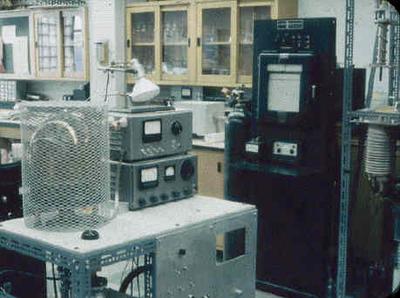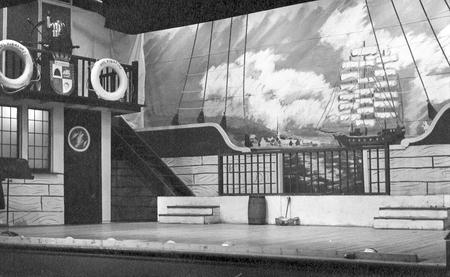Memoirs of a Boffin
Chapter 8: Multinational (1955-1965)
Building up a new Research Laboratory once more was also an exciting prospect. My only hesitation was usurping the position that should rightly have belonged to Ross Warren. Ross was head of the existing advanced development group at RCA Victor to which we had contracted much of the work on the Mid-Canada Line. Ross and I worked harmoniously together and were, by then, very good friends. But, for Ross, it was a case of a prophet being without honour in his own country and I was assured that I was not stealing the position from him. In the event, he joined me without hesitation and was a tower of strength in the Laboratories over the years. This was really the first time that research physicists, with doctorates, had been employed in the Canadian electronics industry or, indeed, in practically any industry in Canada in any significant concentration. In fact, when Ray Jackson did a study for the Canadian Association of Physicists about 1960, I think we had a substantial fraction of the Ph.D. physicists in all Canadian industry at the time.
It was fortunate that TRE had given me years of experience in research management. The interlude in Cambridge had shown that my own creative juices were still flowing. But research management has its drawbacks. It is much more fun to do ones own individual research than to direct a research laboratory. However, the job of a good research director is to attract first-rate scientists and create the environment in which they can be free to develop their ideas and enthusiasms. If the director insists on following his own individual research, he will generally fail at the task of enabling others to follow theirs. Consequently, accepting the position of Director of Research involves a considerable personal sacrifice, which is only compensated by seeing the young scientists blossom and by the widespread recognition of the creativity of the Laboratories as a whole.
Many years ago, when Malenkov disappeared in the Soviet Union, Bob Hope quipped, “He was banished because his agricultural policy failed – none of the people he planted came up.” The same cannot be said about the RCA Victor Research Laboratories of 1955-1965. As it turned out we attracted a remarkably talented and productive group of young scientists – mainly physicists and engineering physicists – many of whom went on to be leaders in industry, government and academic life.
Among the young scientists and engineers I hired in the first year or two, Gilles Cloutier eventually became Rector of the University of Montreal, John Stewart became President of Raytheon Canada, Alan Carswell and Morrel Bachynski became Presidents of their own very successful companies and F.G.R. (Ozzie) Osborne became Chief Scientist of Spar Aerospace. We also produced a Vice-President of Telesat Canada and a couple of Assistant Deputy Ministers; all this from a scientific staff that never exceeded about 30 people during the life of the Laboratories. It was an excellent group and a great pity it was ultimately dispersed as a direct result of an arbitrary reversal of a government decision, some time after I had left.
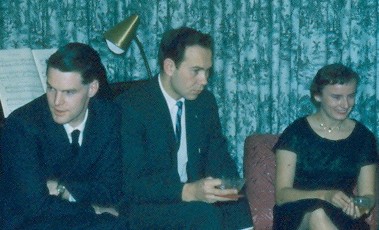
Harry Pullan (L), with Morrel and Slav Bachynski
During the ten years from 1955 to 1965 the labs grew steadily to include divisions on wave propagation, semi-conductor devices, systems, lasers and space. We designed the first 400 Mhz transponder for the Alouette topside sounder satellite and took over from government the engineering design, construction and test of Alouette II and the ISIS series of satellites. We had a very friendly relationship with RCA Princeton, which was headed at the time by Jim Hillier, another Canadian. We competed freely with the US Corporation for US military contracts against Corporate rules, but it was my policy never to compete unless I was sure we could win. The Corporation had more sense than to criticize a winner. Indeed RCA Victor turned out to be an excellent environment in which to achieve innovative results. I had all the freedom I wanted, throughout most of my 10 years there.
I should say something here about the program of research we built up during the first year or two during which it was fully financed by the Company. At that time we had no outside contracts, nor had we sought any. In the first year or two we built up research groups in semiconductors, plasma physics, electronics, microwave propagation and, later lasers.
In the semiconductor Division, headed by Ray Jackson, Harry Pullan grew large single crystals of Germanium and applied them to the ingeneous design of a reliable cooled infra-red detector.
They also with Bob McIntyre conceived, designed and produced the very first solid-state alpha-particle detectors in the world. In plasma physics, Morrel Bachynsky simulated conditions in outer space to study ion propulsion and other spacecraft environmental factors.
In electronics, John Stewart and John Almond studied device physics on which subject they became the corporate experts. John Stewart later designed the first-ever 400 Hz transponder for the Alouette spacecraft. And in radio propagation Hans Neugebauer greatly contributed to the theory of siting microwave systems in rugged terrain. His Division also produced a major work on the transmission of radio waves in planetary atmospheres.
For almost 10 years I ran the labs the way I wanted them and had minimal constraints from the Canadian management or from RCA International, except for an initial skirmish with the parent corporation. Shortly after the labs were completed, the Corporation went through a cost-saving phase, like all organizations do at one time or another. One day I heard that the Executive Vice-President was coming up from New York to announce a decision to close the Canadian labs as a cost-saving measure.
The crucial board meeting was to be the following day. We had about eighteen hours to save the labs. I thought of all the promises I had made to the excellent team I had assembled. I could not let it down. That evening I prepared a report showing that the entire operation would be supported on outside contract starting the following month. According to the report, it would not cost the Corporation anything. Of course the projects described in the report actually represented what we would like to do if we were supported by contract, and the funding we might be able to obtain, without actually saying so. My secretary typed the requisite number of copies of the report that evening, we obtained the key to the boardroom and I placed a copy at the bottom of the pile of papers at each place for the meeting the following day. I called a US friend who alerted Elmer Engstrom (who was then Vice-President R & D, but later became President of the Radio Corporation). Engstrom flew up to Canada and attended the meeting. He was the only executive present who knew the report was there. So it was a surprise to everybody, especially the President of the Canadian Company, when Engstrom called attention to my report as soon as the hatchet-man began to read the requiem on the Canadian laboratories. There was a lot of shuffling of papers, a good deal of muttering, and the meeting broke up in confusion, with the hatchet effort abandoned.
We were left with only the problem of financing the laboratories from outside sources, at a notice of one month. We managed to do it with the help of some of my friends in Ottawa. The Laboratories were largely supported on outside contract for the next seven years, during which period there was hardly any further interference from management on either side of the border. When I was leaving RCA Victor, under very friendly circumstances, the Executive Vice-President who had been stymied ten years before came up to Canada and, at a management meeting, good-humouredly told this story against himself. In all the ten years I was there, he had never let on that he knew.
Our entry into the satellite business came about through an emergency call from John Chapman, whose name will always be associated with the Canadian satellite program. John had graduated from Eaton Electronics Research Laboratory a year or two before I joined its staff. He joined the Defence Research Telecommunications Establishment (DRTE) and created the Topside Sounder Satellite program to extend the scope of his research on the ionosphere. With the help of such able men as Colin Franklin and David Florida (another wartime colleague of mine from TRE), they designed the Alouette series of topside sounder satellites, to observe the ionosphere from above, instead of from below as hitherto. They contracted to industry for some of the essential components. One of the most important, basic systems in a satellite is the transponder which relays to ground, on request, data on the state of all the technical equipment on board. This job was contracted to a company in the USA.
When John Chapman called to us for our help, that contract had been in force over eighteen months and the resulting devices were so bad that he felt that he had to start again. But everything else would be ready for launch in three or four months’ time. So we accepted the challenge to design, engineer and produce the transponder in that time. I gave the job to John Stewart and John Almond, who put on a virtuoso performance and produced a novel and reliable transponder which, like everything else on Alouette, worked perfectly for many years beyond its projected life.
As a result of this, we were asked to participate much more actively in future satellites in the Alouette and ISIS series of topside sounders and we set up a satellite assembly operation to NASA standards in the Lenoir Street building. We subcontracted the spaceframe, mechanical work to the Special Products and Applied Research (SPAR) Division of De Havilland Aircraft in Toronto. The Chief Engineer of the SPAR Division was Dr. Philip A. Lapp, who became a close friend and colleague.
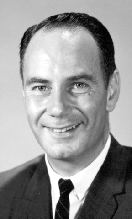
Dr. Philip A. Lapp
Phil and I set up a joint project office for the satellite work in Montreal, jointly headed by John Stewart (later President of Raytheon Ltd.) and John McNaughton, (later President of Spar Aerospace Ltd.). The satellites that resulted from this joint effort were among the most reliable ever built. This cooperative effort set the stage for the later creation of Spar Aerospace from the nucleus of the SPAR Division of De Havilland and, a few years later, the unforeseeable absorption of the remains of the RCA Victor Space Division into Spar Aerospace.
Most of the income of the Laboratories was still from government contracts. We bid on one contract for a major study of the propagation of electromagnetic waves in planetary atmospheres. The client agency was in Boulder Colorado. I had very little hope of getting it against all the US competition, including the RCA Divisions on the East Coast. However, one day I received a call from RCA International in New York. An assistant to the President called to say that I was in deep trouble because we had been awarded a contract in direct competition with RCA Burlington. I asked him for details and it turned out to be the Boulder contract. I told him I hadn’t heard that Burlington was bidding, but it really wouldn’t have made any difference. He became so aggressive that I said “Can I call you back?” and hung up.
I pondered for a moment, then decided to call the contracting authority in Boulder, Colorado, to confirm that we really had been awarded the contract. When the officer there confirmed the news, I asked how many bidders there were. Apparently over 40. How many Canadian? Only one – us!. Which companies constituted the main competition? He named several companies, but not RCA Burlington. So I asked him if he could give me a “ranking” for our RCA competitors. He said, “We don’t rank that far down but, if you want a figure, say 27th.”
So I rang New York. By this time my apoplectic friend there was saying, “I’m going in right now to tell the President about this – you’re in real trouble.” I responded, “By all means let him know that we won the contract and that Burlington came in 27th in a list of 40 companies. Then ask him whether he wanted the contract in the Corporation or not.” I never heard another word about competing with the parent Corporation all the time I was with RCA. As I had learned long before, you can stick your neck out as far as you like in US corporate society and no-one will chop it off as long as you win. But watch out the first time you lose! Fortunately I never lost.
While I was at RCA Victor in 1961, I served on the R and D side of the Royal Commission on Government Organization (the Glassco Commission) which, inter alia, studied and recommended on the organization of science and technology in government. Ron Ritchie, who was later to become a colleague of mine in Club of Rome activities, was the Executive Director of the Commission. They had tried to recruit the Vice-President of a large corporation as head of the Science and Technology team but, at the last minute, had been sent one of his managers as a substitute. In the event, this arrangement did not work well and he participated in only the early stages of the project. The four essentially full-time members of the team were Dr. Bob Weir, Dr. Trevor Lloyd, Dr. Arthur Porter, and myself.
Bob Weir was Dean of Agriculture in the University of Manitoba, formerly of Guelph. This collaboration with Bob led to our even closer association about five years later. when I invited him to join the Science Secretariat in the Privy Council Office in Ottawa.
Trevor Lloyd, a McGill geographer, was a leading expert on the North and also a quite delightful, erudite colleague. We co-opted several others, including Dean Dick Dillon of the University of Western Ontario and John Campanero, a Vice-President of Westinghouse, in the course of the work. Trevor Lloyd and I ended up editing the group’s final report to the Commissioners. I had concentrated on the National Research Council (NRC) and Atomic Energy of Canada Ltd. (AECL). Somewhere in the archives, no doubt, is our lengthy report. Judging by the problems NRC has encountered over the last 25 years and AECL is undergoing now, it would still merit study.
I had known Arthur Porter as a graduate student at Manchester, when I was an undergraduate. A pioneer in the mechanical precursors of computers, called integrating machines, Arthur had done his post-doctoral work at MIT. He spent the war in our sister establishment RRDE in Malvern – the Army equivalent of TRE. He become a professor at the Royal Military College in the UK, before joining Ferranti Ltd. in Toronto. He was a man with a mind of remarkable originality and a spirit of boundless enthusiasm. It was a pleasure to work with him on the Royal Commission.
NRC had suffered for many years from the albatross of a well-meaning but over-protective Council and was (1961) already suffering from an aging scientific staff. The President, Dr. E.W.R. Steacie had done a remarkable post-war job of encouraging fundamental research and thereby attracting some first-rate scientists, first into his own field of chemistry and then into all the physical and biological sciences. However, there had not been much mobility of staff, partly because NRC was, without doubt and in spite of it faults, still the most attractive place in Canada in which to do research; but mainly because there were few other places a government scientist could go to and retain his seniority and pension rights. The active research community (which excludes bureaucrats with a “research” label and teaching professors who only profess to do research) was then and is today much too small for the size of the country.
The NRC situation was complicated by the fact that engineers, who had first been hired to support the research, had by 1961, built up engineering divisions that were now larger than the research side of NRC. I spent a good deal of time with Steacie who admitted to me that this growth had happened “behind his back”, in other words not as a result of any initiative by him, albeit with his tacit agreement. The engineering divisions were operated in the same spirit of freedom as the scientific divisions. Indeed the criteria for the employment of engineers were precisely the same as those for scientists, which made it practically impossible to hire a first-rate practical engineer who did not have a long list of publications. There was a lot of hypocrisy in the hiring practices at the time and I earned no brownie points for calling attention to it.
Moreover NRC had no clearly identifiable mission – no statement of purpose beyond Steacie’s edict to “do research”, which was exactly what was needed just after the war, but no longer adequate for Treasury Board in 1961. NRC was organized on academic lines with Divisions called “Physics”, “Chemistry”, “Biology” etc. It was obvious that the absence of specific missions and the relative inability to do transdisciplinary research would eventually catch up with it, thereby threatening the very thing it was good at – fundamental research. Steacie was aware of this but saw it as a job for his successor. His love was for fundamental research and he had already made his magnificent contribution to NRC by that time. In fact, he confided in me the year before he died that one of his hopes had been to end his career as Principal and Vice-Chancellor of McGill University, but no-one had offered him the job. Unhappily he died the following year. The reluctance of a succession of ineffectual post-Steacie managements to define NRC’s specific missions caught up with NRC in the 1980s. Two decades of benign neglect left NRC vulnerable and it eventually suffered serious unreasoned budget cuts under the Mulroney Government. Some missions were eventually defined, but they may be of such a nature as to drive NRC towards becoming a technological job-shop, like the majority of the provincial research councils.
At the time of the Royal Commission (1961), suggestions made in our draft report to the Commissioners that NRC could actually be improved by certain changes, raised the hackles of its blind defenders on the NRC Council. The Royal Commission had formed an Advisory Committee of distinguished scientists, many of whom were obviously on the NRC Council. I presented a first draft of the NRC chapter of the Commission Report to the first meeting of this Committee. It was chaired by Gordon Shrum, the big, bluff physicist from UBC. Shrum was determined from the beginning to protect the status quo of NRC. Actually, I believe many Council members on the Committee, were embarrassed by the Chairman’s attitude but did not want to initiate a fight which might split the Council.
By the end of the meeting I was feeling rather fed up. – I would rather be back in Montreal doing some real work. So I went with the Executive Director, Ron Ritchie to the Head of the Royal Commission, Grant Glassco, and told him that what had happened at the meeting made such advisory meetings useless. Glassco asked me “What do you suggest we do about it?” I said “Whose responsibility is it to call the Advisory Committee” After some hesitation he said, “I suppose it’s mine.” “Well, I said, “I suggest you never call it again.” I believe he never did. At least, I had no further trouble.
Four or five years later, when I was in the Privy Council Office, Shrum dropped in one day to congratulate me on my appointment as Principal Science Advisor and commented that our section of the Glassco Report was “a dam’ good piece of work”. It was his way of gracefully accepting a fait accompli.
I was glad to settle back in Montreal after a year in which I had spent Monday to Thursday in Ottawa, and the remainder of the week in Montreal. In 1954 I had become involved with the production of Gilbert and Sullivan Operettas. Our Anglican parish church, St. Paul’s, Lachine, had put on a successful production of the short piece, “Trial by Jury” the year before and they had decided to create a “St. Paul’s Operatic Society”. I had not attended that performance, but I was invited to participate in plans for the next. Before I realized what I was letting myself in for, I was Production Manager and, before long President of the Society.
We decided to put on “The Sorcerer” as our first full-scale production. It has a wonderful scene where the sorcerer, John Wellington Wells, “the dealer in magic and spells” points dramatically at various places on stage and causes a flash and a puff of smoke to emphasize his words. The trick is to trigger these flashes at exactly the right time in exactly the right place so that they appear to be projected from his finger. I used magnesium powder in small metal trays and fused a fine wire embedded in it to trigger the flash. There were several of these scattered all round the stage and one big one at the bottom of a set of steps at centre stage rear. They were controlled from a switchboard lookout in a loft above stage right. I had a row of buttons which were only armed by throwing a safety switch seconds before the action. The result apparently impressed the local audience. It really did look as though the sorcerer himself generated the flashes. And the final big flash, below the steps blinded the audience for the two seconds it took the sorcerer to vanish by rolling off the platform behind it.
However, at one performance, I had just armed the buttons, ready for the scene, when a large hand descended on the sill of the lookout, missing the end button by about a quarter of an inch. It was a member of the cast who was “just curious”. Anyone who works backstage will tell you that members of the cast are a menace offstage. This was no exception. He was greatly sobered when I pointed out, afterwards that the button his hand just missed was the one that fired the big flash at the bottom of the steps; and, that at the moment he did it, the heroine in a long flimsy dress was standing right above that flashpan.
Our stage director was Doris Norris. She and her husband Harry had emigrated to Canada before World War II. Harry had been musical director of the D’Oyly Carte Opera Company after Sir Malcolm Sargent and before Isidore Godfrey, who stayed with it for many years. Harry Norris had toured with the D’Oyly Carte in North America and I guess the Norrises thought Canada would be a nice place to live. Doris had also performed with the Company, as the leading soubrette. They had settled in Montreal West and had formed the Montreal West Operatic Society, which had been running for many years. We enticed Doris to do our stage direction at St. Paul’s as well and then worked on Harry to be musical director. In turn they persuaded me to help with the Montreal West productions and we all three found ourselves doing two productions every winter.
President and Production Manager sound like very imposing titles, but, in an amateur company they can mean anything from scenic design, stage carpentry, lighting and properties to advertising and box-office management. I did it all, at one time or another, depending on the type of help that was available.
I believe it was in the second year that we did H.M.S. Pinafore. I thought the set design and construction was not bad for a new group. We did more than a dozen G & S productions together.
“Ruddigore” was also a lot of fun. The scene where the pictures come to life and leave their frames challenges the ingenuity of an amateur producer. We built turntables, bisected by the full-size portraits standing on them. The actor, dressed identically, stood behind the picture. On the fateful chord, there was a blackout while stage-hands rotated all seven pictures so that the audience would now see the real figures standing in front of a black background, in place of the pictures. The problem was you could never predict exactly how long it would take to get all the pictures turned and the scenery at rest – anything from five to twelve seconds. I rigged a small signal light on the conductor’s podium. The start of the orchestra’s long chord was the signal for the blackout. Then Harry waited for my signal light before he ended the chord. So the timing was quite perfect every night. The audience had no idea that the process took longer some evenings than others. It is the illusion that counts.
At the time we were producing Gilbert and Sullivan Operettas in Lachine and Montreal West, Harry Norris was the only living man involved in such productions who had worked directly with Gilbert himself. His libretti were covered with notes scribbled in Gilbert’s hand. I wonder where they are now. Harry and Doris moved back to Britain, where they died a few years later. Their son was a fine pianist and he and their daughter-in law, a violinist, joined Yehudi Menuhin as instructors in his music school.
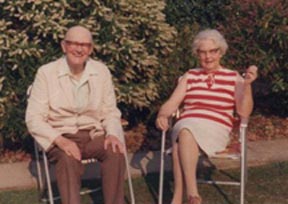
Harry and Doris Norris: Two of the nicest people I have known
Years later we visited Harry and Doris in their retirement house in the South of England. It was a wonderful reunion but, as we left we realised sadly that we were unlikely ever to see them again. We never did. However we came away with the happy picture that was taken in their garden during that visit.
Over the same period (1955-1965), I did several productions with the Lachine Civic Theatre, presided over by that delightful lady, long deceased, Miss Ivy Ashworth. I still have a broken pair of scissors she ‘lent’ me. I was backstage every night of every production of all these bodies, generally as my own stage manager. That was my reward for all the work it involved.
By 1965, the RCA Victor Research Laboratories were flourishing. We had a perennial arrangement for funds from the U.S. Air Force, Cambridge who seemed to regard us in much greater favour than they held our RCA competitors south of the border. We also had a standing arrangement with the RCA Laboratories, Princeton N.J. who funded our electronic device circuit work. The satellite activity was very successful and our semiconductor infra-red detectors were easily beating the Hughes Aircraft competition. Members of our research staff had published a couple of books [1] [2] and more papers in scientific journals than the entire Physics Department of McGill University over the same period. It was at this point that the ghost of the Royal Commission caught up with me.
1. The Particle Kinetics of Plasmas, by Scharofsky, Johnston and Bachynski; W.B. Saunders, 1966.
2. Table of Laplace Transforms, by Roberts and Kaufman, Addison Wesley, 1966.
In the Royal Commission Report, we had recommended the establishment of a very small scientific advisory group at the centre of government, in fact in the Treasury Board. When faced with this recommendation, Lester Pearson asked the advice of the eminence grise of Canadian science and technology, Dr. C.J. “Jack” Mackenzie, formerly President of NRC who had been closely involved in organizing Canadian participation in the development of radar and nuclear fission. In a report to Pearson, Jack Mackenzie suggested that the Government follow the recommendations of the Glassco report but recommended that they locate the advisory body in the Privy Council Office rather than in the Treasury Board. So, in 1964, a leading metallurgist, Dr. Frank Forward was asked to join the Privy Council Office, at Deputy Minister level, to create a small “Science Secretariat” to advise Cabinet and, in particular, the Chairman of the Cabinet Committee on Scientific and Industrial Affairs, on science as a factor in government policy.
Early in 1965, the inevitable happened. The Prime Minister, Lester B. Pearson sent Jack Mackenzie to Montreal to invite me to join Dr. Forward as Deputy Director of the Science Secretariat at the level of Assistant Secretary (Assistant Deputy Minister). Leaving RCA Victor was the last thing in my mind and I declined the invitation, without giving it much thought. A few weeks later, Jack Mackenzie appeared again and, this time placed some pressure both on me and on the Company, in the person of our President, John Houlding. John had taken over a few years before and always gave strong support to the Research Laboratories, so there was every reason for me to stay. However, Ottawa prevailed; it was a case of putting my money where my Royal Commission mouth was – or something like that. So, after a hectic summer (1965) I spent trying to do both jobs at once, we moved to Ottawa with our two children, Valerie (15) and Michael (9).

